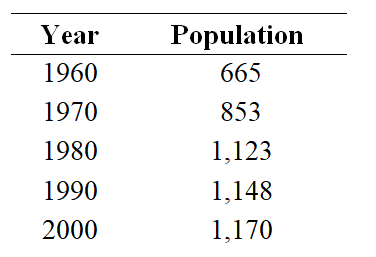The table that follows gives the population of a city. Find the power function that best fits the data, with x equal to the number of years past 1950. According to the model, will the city's population be greater than 1,400 by the year 2010? Round your final answer to three decimal places. 
A)  The model predicts that the population will not be greater than 1,400.
The model predicts that the population will not be greater than 1,400.
B)  The model predicts that the population will not be greater than 1,400.
The model predicts that the population will not be greater than 1,400.
C)  The model predicts that the population will be greater than 1,400.
The model predicts that the population will be greater than 1,400.
D)  The model predicts that the population will be greater than 1,400.
The model predicts that the population will be greater than 1,400.
E)  The model predicts that the population will not be greater than 1,400.
The model predicts that the population will not be greater than 1,400.
Correct Answer:
Verified
Q110: Suppose the following table gives the U.S.
Q111: Determine what type of function best models
Q112: The table gives the percent of the
Q113: Determine whether the scatter plot should be
Q114: Find the equation of the quadratic function
Q116: Graph the cubic function that models the
Q117: The table shows the average earnings of
Q118: Find the equation of the quartic function
Q119: Find the equation of the cubic function
Q120: Graph the quadratic function that models the
Unlock this Answer For Free Now!
View this answer and more for free by performing one of the following actions

Scan the QR code to install the App and get 2 free unlocks

Unlock quizzes for free by uploading documents